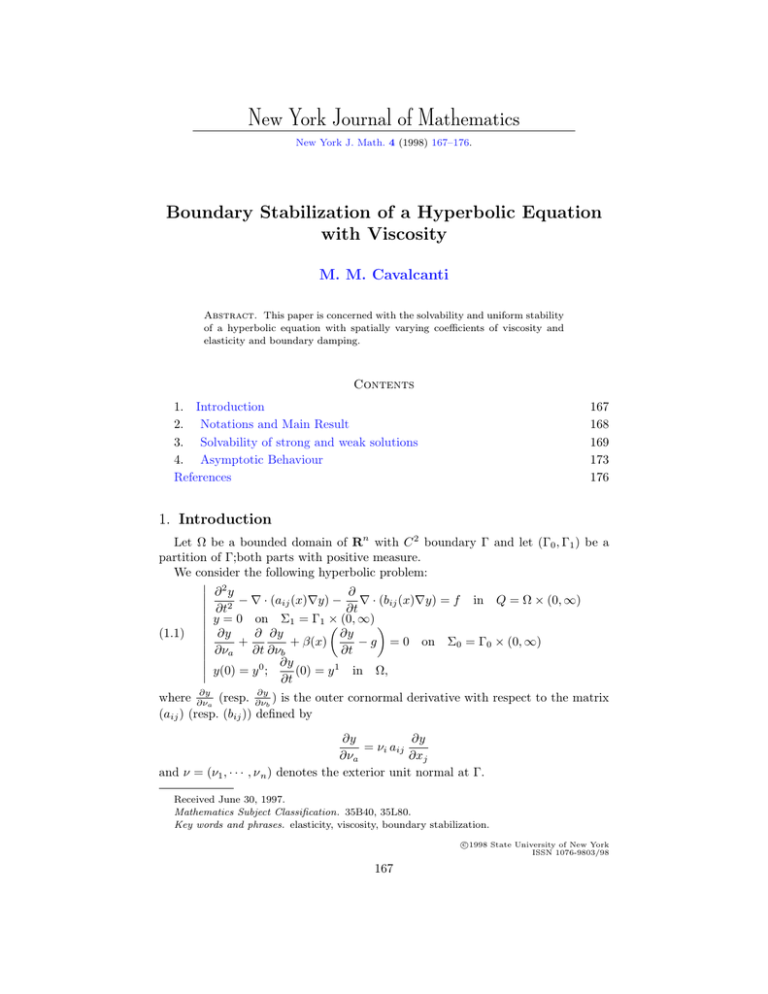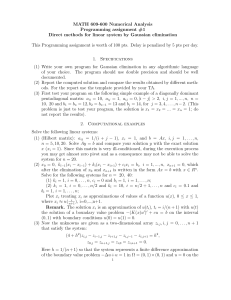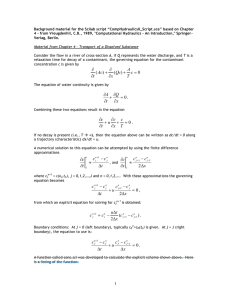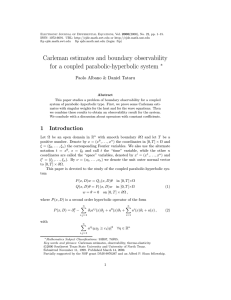New York Journal of Mathematics Boundary Stabilization of a Hyperbolic Equation
advertisement

New York Journal of Mathematics
New York J. Math. 4 (1998) 167–176.
Boundary Stabilization of a Hyperbolic Equation
with Viscosity
M. M. Cavalcanti
Abstract. This paper is concerned with the solvability and uniform stability
of a hyperbolic equation with spatially varying coefficients of viscosity and
elasticity and boundary damping.
Contents
1. Introduction
2. Notations and Main Result
3. Solvability of strong and weak solutions
4. Asymptotic Behaviour
References
167
168
169
173
176
1. Introduction
Let Ω be a bounded domain of Rn with C 2 boundary Γ and let (Γ0 , Γ1 ) be a
partition of Γ;both parts with positive measure.
We consider the following hyperbolic problem:
2
∂ y
∂
∂t2 − ∇ · (aij (x)∇y) − ∂t ∇ · (bij (x)∇y) = f in Q = Ω × (0, ∞)
y = 0 on Σ1 = Γ1 ×
(0, ∞) ∂ ∂y
∂y
(1.1) ∂y
− g = 0 on Σ0 = Γ0 × (0, ∞)
+
+ β(x)
∂νa
∂t ∂νb
∂t
∂y
(0) = y 1 in Ω,
y(0) = y 0 ;
∂t
∂y
∂y
where ∂ν
(resp. ∂ν
) is the outer cornormal derivative with respect to the matrix
a
b
(aij ) (resp. (bij )) defined by
∂y
∂y
= νi aij
∂νa
∂xj
and ν = (ν1 , · · · , ν n ) denotes the exterior unit normal at Γ.
Received June 30, 1997.
Mathematics Subject Classification. 35B40, 35L80.
Key words and phrases. elasticity, viscosity, boundary stabilization.
c
1998
State University of New York
ISSN 1076-9803/98
167
168
M. M. Cavalcanti
In physical terms the entries aij and bij are related to coefficients of elasticity and
viscosity, respectively. Without viscosity, i.e., if bij = 0 and assuming that aij = 1,
f = 0 and g = 0, the problem (1.1) was studied by many authors: See J. P. Quinn
and D. L. Russell [10], G. Chen [2, 3, 4], J. E. Lagnese [7, 8] and V. Komornik and
E. Zuazua [6]. And when β = 0, an asymptotic regularization procedure is proved
by G. C. Hsiao and J. Sprekels [5]. Inspired by the above works we show solvability
of strong and weak solutions to problem (1.1), and obtain boundary stabilization.
To obtain the existence of solutions we make use of Galerkin’s aproximation.
However, as we are also interested in srong solutions we have some technical difficulties wich lead us to transform the problem (1.1) into an equivalent one with
zero initial data.
Stability problems with nonhomogeneous conditions require a special treatement
because we don’t have any information about the influence of the inner products
(f (t), y 0 (t))L2 (Ω) and (g(t), y 0 (t))L2 (Γ0 ) on the energy
Z
Z
1
1
∂y
∂y
E(t) =
(1.2)
|y 0 (x, t)|2 dx +
aij (x)
(x, t)
(x, t) dx
2 Ω
2 Ω
∂xi
∂xj
or about the sign of its derivative E 0 (t).
To obtain the uniform decay we use the perturbed energy method. Our paper
is organized as follows. In Section 2 we give notations and state our main result.
In Section 3 we prove solvability of strong and weak solutions of (1.1) while in
Section 4 we obtain the boundary stabilization of solutions from Section 3.
2. Notations and Main Result
We define
Z
(u, v) =
Ω
Z
(u, v)Γ0 =
and let V be
Z
u(x)v(x) dx; |u|2 =
Γ0
|u|2Γ0
u(x)v(x) dx;
Ω
|u(x)|2 dx,
Z
=
Γ0
|u(x)|2 dx
V = {v ∈ H 1 (Ω) ; v = 0 on Γ1 }
which, equipped with the topology |∇ · | is a Hilbert subspace of H 1 (Ω).
In order to establish our main result, we make the following assumptions on the
coefficients:
aij , bij ∈ C 1 (Ω).
(2.1)
There exist positive constants a0 and b0 such that
n
X
aij = aji , and for ξ ∈ Rn ,
(2.2)
aij ξi ξj ≥ a0 |ξ|2
(2.3)
bij = bji ,
(2.4)
∞
and for ξ ∈ Rn ,
i,j=1
n
X
bij ξi ξj ≥ b0 |ξ|2 ,
i,j=1
β ∈ L (Ω); β(x) ≥ 0
and β(x) → 0
a.e. on
Γ0 , β(x) = 0 ∀x ∈ Γ0 ∩ Γ1
whenever x tends to a point
x ∈ Γ0 ∩ Γ1 .
This choice of the function β was done in order to avoid eventual singularities.
Boundary Stabilization of a Hyperbolic Equation
Defining
(2.5)
a(u, v) =
(2.6)
b(u, v) =
n Z
X
i,j=1 Ω
n Z
X
i,j=1
Ω
ai,j (x)
bi,j (x)
169
∂u ∂v
dx, ∀u, v ∈ V
∂xi ∂xj
∂u ∂v
dx, ∀u, v ∈ V
∂xi ∂xj
from (2.1), (2.2) and (2.3) there exist positive constants a0 , a1 , b0 and b1 such that
(2.7)
a0 |∇u|2 ≤ a(u, u) ≤ a1 |∇u|2 , ∀u ∈ V
(2.8)
b0 |∇u|2 ≤ b(u, u) ≤ b1 |∇u|2 , ∀u ∈ V.
Now, we are in position to state our main result.
Theorem 2.1. Let
0 1
y , y , f, g ∈ V × L2 (Ω) × L2 (0, ∞; L2 (Ω)) × H 1 (0, ∞; L2 (Γ0 )).
Under the assumptions (2.1)-(2.3) and assuming that g(0) = 0, the problem (1.1)
possesses a unique weak solution y : Ω × (0, ∞) → R such that
(2.9)
y ∈ L∞ (0, ∞; V ), y 0 ∈ L∞ (0, ∞; L2 (Ω)).
Moreover, provided that for large t, the inequality
Z t
p
ε (2.10)
exp( s) |f (s)|2 + | βg(s)|2Γ0 ds ≤ αtr
2
0
holds for some positive constants ε, α, and r, we obtain the following energy decay
ε
E(t) ≤ C exp(− t), ∀t ≥ 0 and ∀ε ∈ (0, ε0 ]
2
where C and ε0 are positive constants.
Remark 1. The hypothesis (2.10) means that the map
Z t
p
ε exp( s) |f (s)|2 + | βg(s)|2Γ0 ds
t 7−→
2
0
must be bounded by a polinomial P (t).
3. Solvability of strong and weak solutions
In this section we are going to prove the existence of strong solutions of problem
(1.1). Using density arguments we conclude the same for weak solutions. The existence of solutions may be proven either by the Galerkin method or using semigroup
arguments. We employ the Galerkin method.
We define the Hilbert space
(3.1)
H = u ∈ V ; Au, Bu ∈ L2 (Ω)
where A and B are the operators defined by
∂
∂
∂
∂
aij (x)
and B = −
bij (x)
A=−
∂xi
∂xj
∂xi
∂xj
and H is endowed by the natural inner product
(u, v)H = (u, v)V + (Au, Av) + (Bu, Bv).
170
M. M. Cavalcanti
Let us consider
y0 , y1 ∈ H
(3.2)
satisfying the compatibility condition
∂y 1
∂y 0
+
+ β(x) y 1 − g(0) = 0.
∂νa
∂νb
In addition, let us assume that
(3.3)
f ∈ H 1 (0, ∞; L2 (Ω)), g ∈ H 2 (0, ∞; L2 (Γ0 )).
(3.4)
The variational formulation associated with problem (1.1) is given by
(y 00 (t), w) + a(y(t), w) + b(y(t), w) + (βy 0 (t), w)Γ0
= (f (t), w) + (βg(t), w)Γ0 ; ∀w ∈ V.
In order to obtain strong solutions and since we can not use a ‘special basis’
(for instance, one formed by eigenfunctions) because of the boundary condition
(βy 0 (t), w)Γ0 , we need to derive the above expression with respect to t. But it
lead us to technical difficulties when we estimate y 00 (0). To solve this problem we
transform the boundary value problem (1.1) into an equivalent one with null initial
data. In fact, considering the change of variables
(3.5)
v(x, t) = y(x, t) − φ(x, t)
where
φ(x, t) = y 0 (x) + ty 1 (x), (x, t) ∈ Ω × [0, ∞)
we obtain the equivalent problem for v :
(3.6)
v 00 − ∇ · (aij (x)∇v) − ∇ · (bij (x)∇v 0 ) = F
v = 0 on Σ1
∂v 0
∂v
+
+ βv 0 = G on Σ1
∂νa
∂νb
v(0) = v 0 (0) = 0
in Q
where
(3.7)
(3.8)
F = f + ∇ · (aij (x)∇φ) + ∇ · (bij (x)∇φ0 )
G = βg −
∂φ
∂φ0
−
− βφ0 .
∂νa
∂νb
If v is a solution of (3.6) in [0,T], then y = v + φ is a solution of (1.1) in the same
interval. However, after two estimates we are going to prove later, we have that
(3.9)
|Av(t)|2 + |∇v 0 (t)|2 ≤ C(T ), ∀t ∈ [0, T ] and ∀T > 0.
Thus, from (3.4) and (3.5) we have the same estimate obtained in (3.9) for the
solution y. So, we can extend y to the whole interval [0, ∞) using the standard
argument
lim |Av(t)|2 + |∇v 0 (t)|2 = ∞.
Tmax = ∞ or if Tmax < ∞ then
t→Tmax
Hence, it is sufficient to prove that (3.6) has a solution in [0,T], which will be
done by the Galerkin method.
Boundary Stabilization of a Hyperbolic Equation
171
We represent by (ων ) a basis in H, which is orthonormal in L2 (Ω), by Vm the
subspace of H generated by the m-first vectors ω1 ,· · · , ωm and define
(3.10)
vm (t) =
m
X
gim (t)ωi
i=1
where vm (t) is the solution of the folowing Cauchy problem:
(3.11)
00
0
0
(t), ωj ) + a(vm (t), ωj ) + b(vm
(t), ωj ) + (βvm
(t), ωj )Γ0
(vm
= (F (t), ωj ) + (G(t), ωj )Γ0 ;
0
vm (0) = vm
(0) = 0; j = 1, · · · , m.
The aproximate system is a normal one of ordinary differential equations. It has
a solution in [0, tm ). The extension of the solution on the whole interval [0,T] is a
consequence of the first estimate we are going to obtain below.
3.1. A Priori Estimates.
0
3.1.1. The First Estimate. Multiplying both sides of (3.11) by gjm
(t), summing
over 1 ≤ j ≤ m and considering (2.2), we obtain
(3.12)
p
2
o
1 d n 0
2
0
0
0
|vm (t)| + a(vm (t), vm (t)) + b(vm
(t), vm
(t)) + βvm
(t)
2 dt
Γ0
d
0
0
= (F (t), vm (t)) +
(G(t), vm (t))Γ0 − (G (t), vm (t))Γ0
dt
1
1 0
d
C2
1
2
2
2
2
(G(t), vm (t))Γ0 + 0 |G0 (t)|Γ0 + |∇vm (t)|
≤ |F (t)| + |vm
(t)| +
2
2
dt
2
2
where C0 is a positive constant such that |v|Γ0 ≤ C0 |∇v| , ∀v ∈ V.
Integrating (3.12) over (0,t) 0 < t < tm , taking into consideration (2.7) and (2.8)
0
(0) = 0, we get
and noting that vm (0) = vm
Z t
Z t p
2
a0
1 0
2
2
2
0
0
|vm (t)| +
|∇vm (t)| + b0
(3.13)
|∇vm
(s)| ds +
(s) ds
βvm
2
2
Γ0
0
0
2
C
1
≤ kF k2L2 (0,T ;L2 (Ω)) + 0 kG0 k2L2 (0,T ;L2 (Γ0 )) + (G(t), vm (t))Γ0
2
2
Z
o
1 tn 0
2
2
|vm (s)| + |∇vm (s)| ds.
+
2 0
On the other hand, for ar arbitrary η > 0 we have
(3.14)
(G(t), vm (t))Γ0 ≤
C02
2
2
|G(t)|Γ0 + η |∇vm (t)| .
4η
Combining (3.13), (3.14) and choosing η > 0 small enough, we obtain the first
estimate
Z t
Z t p
2
2
2
2
0
0
0
|vm
(3.15)
(t)| + |∇vm (t)| +
|∇vm
(s)| ds +
(s) ds ≤ L1
βvm
0
0
Γ0
where L1 is a positive constant independent of m ∈ N and t ∈ [0, T ].
172
M. M. Cavalcanti
00
(0) in L2 (Ω)
3.1.2. The Second Estimate. First of all we are going to estimate vm
0
(0) = 0, it
norm. Taking t = 0 in (3.11) and taking into account that vm (0) = vm
follows that
00
(0), ωj ) = (F (0), ωj ) + (G(0), ωj )Γ0 .
(vm
(3.16)
From (3.3) and (3.8) we have that G(0) = 0, and from (3.16) we conclude
2
00
00
(0)| = (F (0), vm
(0))
|vm
which implies that
00
(0)| ≤ L; ∀m ∈ N
|vm
(3.17)
where L is a positive constant independent of m ∈ N.
Now, taking the derivative of (3.11) with respect to t, we can write
(3.18)
000
0
00
00
(t), ωj ) + a(vm
(t), ωj ) + b(vm
(t), ωj ) + (βvm
(t), ωj )Γ0
(vm
= (F 0 (t), ωj ) + (G0 (t), ωj )Γ0 .
00
Multiplying both sides of (3.18) by gjm
(t) and summing over 1 ≤ j ≤ m, we
obtain
p
2
o
1 d n 00
2
0
0
00
00
00
(3.19)
|vm (t)| + a(vm
(t), vm
(t)) + b(vm
(t), vm
(t)) + βvm
(t)
2 dt
Γ0
d
00
0
0
(G0 (t), vm
= (F 0 (t), vm
(t)) +
(t))Γ0 − (G00 (t), vm
(t))Γ0 .
dt
Using arguments analogous to those considered in the first estimate, observing
0
(0) = 0, and taking into account (3.17), from (3.19) we obtain the second
that vm
estimate
Z t
Z t p
2
2
2
2
00
0
00
00
(3.20)
|∇vm (s)| ds +
(s) ds ≤ L2
|vm (t)| + |∇vm (t)| +
βvm
0
0
Γ0
where L2 is a positive constant independent of m ∈ N and t ∈ [0, T ].
Due to estimates (3.15) and (3.20) we can extract a subsequence {vµ } of {vm }
such that
(3.21)
vµ * v
weak star in
L∞ (0, T ; V )
(3.22)
vµ0 * v 0
weak star in
L∞ (0, T ; V )
(3.23)
(3.24)
(3.25)
vµ00 * v 00
vµ00 * v 00
weak in
weak star in
βvµ0 * βv 0
weak in
L2 (0, T ; V )
L∞ (0, T ; L2 (Ω))
L2 (0, T ; L2 (Γ0 )).
The above convergences are sufficient to pass to the limit.
3.2. Uniqueness. Supose we have two solutions y and ŷ of problem (1.1). Then
z = y − ŷ satisfies
(3.26)
(z 00 (t), w) + a(z(t), w) + b(z 0 (t), w) + (βz 0 (t), w)Γ0 = 0, ∀w ∈ V
z(0) = z 0 (0) = 0.
Boundary Stabilization of a Hyperbolic Equation
173
Taking w = 2z 0 (t) in (3.26) we obtain
p
2
o
d n 0 2
|z (t)| + a(z(t), z(t)) + 2b(z 0 (t), z 0 (t)) + 2 βz 0 (t) = 0.
(3.27)
dt
Γ0
Integrating (3.27) over (0,t) we obtain
Z t
Z t p
2
2
2
2
0
0
|∇z (s)| ds + 2
|z (t)| + a0 |∇z(t)| + 2b0
βz 0 (s) ds = 0
0
Γ0
0
0
which implies that |∇z(t)| = |z (t)| = 0. This completes the proof.
3.3. Solvability of weak solutions. We have just proved the existence of solutions of the problem (1.1) when y 0 and y 1 are smooth. By density arguments we
conclude the same for weak solutions. However, the principal difficulty is due to the
existence of a sequence of initial data which satisfies
the
hypothesis of compatibility
(3.3). For this end and since g(0) = 0, given y 0 , y 1 ∈ V × L2 (Ω) it is sufficient
to consider
∂u
= 0 on Γ0
yµ0 ∈ D(A) = u ∈ V ; Au ∈ L2 (Ω) and
∂νa
such that
yµ0 → y 0 in V
and
yµ1 ∈ D(B) ∩ H01 (Ω)
yµ1 → y 1
such that
in L2 (Ω).
The uniqueness of weak solutions requires a regularization procedure and can
be obtained using the standard method of Visik-Ladyshenskaya, cf. J. L. Lions [9]
Chapter 3, Section 8.2.
4. Asymptotic Behaviour
In this section we obtain the uniform decay of the energy given in (1.2) for
strong solutions, since the same occurs for weak solutions using standard density
arguments.
The derivative of the energy given by (1.2) is
p
2
(4.1)
E 0 (t) = −b(y 0 (t), y 0 (t)) − βy 0 (t) + (f (t), y 0 (t)) + (g(t), y 0 (t))Γ0 .
Γ0
Let λ and µ be positive constants such that
(4.2)
and
(4.3)
|v|2 ≤ λ|∇v|2
∀v ∈ V
p 2
βv ≤ µ|∇v|2 ; ∀v ∈ V.
Γ0
For an arbitrary ε > 0 we define the perturbed energy
(4.4)
Eε (t) = E(t) + εψ(t)
where
(4.5)
Z
ψ(t) =
Ω
y 0 ydx.
174
M. M. Cavalcanti
Proposition 4.1. There exists C1 > 0 such that
|Eε (t) − E(t)| ≤ εC1 E(t), ∀t ≥ 0 and ∀ε > 0.
Proof. From (2.7), (4.2) and (4.5) we obtain
(4.6)
|ψ(t)| ≤
1 0 2 1 −1
|y | + λ a0 a(y, y) ≤ λa−1
0 + 1 E(t).
2
2
If we define C1 = λa−1
0 + 1,then from (4.4) and (4.6) we can write
|Eε (t) − E(t)| = ε|ψ(t)| ≤ εC1 E(t).
This concludes the proof.
Proposition 4.2. There exist C2 = C2 (ε) and ε1 positive constants such that
p
Eε0 (t) ≤ −εE(t) + C2 |f (t)|2 + | βg(t)|2Γ0 ; ∀t ≥ 0 and ∀ε ∈ (0, ε1 ].
Proof. First of all we must estimate ψ 0 (t) in terms of E(t). Taking the derivative
of ψ(t) given in (4.5) and replacing y 00 by ∇ · (aij (x)∇y) + ∇ · (bij ∇y 0 ) + f in the
expression obtained it follows that
(4.7)
Z
0
ψ (t) =
Ω
Z
∇ · (aij (x)∇y) y dx +
Z
0
Ω
∇ · (bij ∇y ) y dx +
Ω
Z
f y dx +
Ω
|y 0 |2 dx.
On the other hand, from Gauss’ theorem and taking into account that
∂y 0
∂y
+
= β(g − y 0 )
∂νa
∂νb
on Γ0
we obtain
Z
Z
∇ · (aij (x)∇y) y dx +
∇ · (bij ∇y 0 ) y dx
(4.8)
Ω
Ω
= −a(y(t), y(t)) − b(y 0 (t), y(t)) −
Z
Γ0
Replacing (4.8) in (4.7); adding and subtracting the term
(4.9)
0
0
Z
ψ (t) = −2E(t) − b(y (t), y(t)) + 2
0 2
Ω
|y | dx −
Z
Γ0
0
βy 0 y dΓ +
R
Ω
βy y dΓ +
Z
Γ0
βgy dΓ.
|y 0 |2 dx in (4.7) we get
Z
Ω
Z
f y dx +
Γ0
βgy dΓ.
Now, from (2.7), (4.2), (4.3) and (4.9), using for an arbitrary η > 0 the inequality
a2
+ ηb2 we can write
ab ≤ 4η
||b||2 a−1
2
0
0
|∇y 0 (t)|
ψ (t) ≤ − (2 − 8η)E(t) + 2λ +
(4.10)
4η
p
2
p
2 µa−1
a−1
0
2
0 0 λ
+
|f (t)| + βg(t)
βy (t) +
4η
4η
Γ0
Γ0
where
||b|| =
n
X
i,j=1
||bij ||L∞ (Ω) .
Boundary Stabilization of a Hyperbolic Equation
Choosing η =
1
8
175
from (4.10) we have
(4.11)
2
p
2 p
0
2
ψ (t) ≤ −E(t) + M1 |∇y (t)| + M2 βy (t) + M3 |f (t)| + βg(t)
0
0
2
Γ0
Γ0
where
and M3 = 2a−1
, M2 = 2µa−1
M1 = 2 λ + ||b||2 a−1
0
0
0 λ.
Thus, combining (2.8), (4.1), (4.4) and (4.11), we conclude
Eε0 (t) = E 0 (t) + εψ 0 (t)
p
2
2
≤ −b0 |∇y 0 (t)| − βy 0 (t) + (f (t), y 0 (t)) + (βg(t), y 0 (t))Γ0 − εE(t)
Γ0
2
p
2 p
2
+ εM1 |∇y 0 (t)| + εM2 βy 0 (t) + εM3 |f (t)|2 + βg(t)
Γ0
Γ0
which implies
(4.12)
p
2
2
Eε0 (t) ≤ − (b0 − ε(M1 + 1)) |∇y 0 (t)| − (1 − ε(M2 + 1)) βy 0 (t)
Γ0
1
λ
2
2
+ εM3 |f (t)| +
+ εM3 |g(t)|Γ0 .
− εE(t) +
4ε
4ε
Defining
1
b0
,
ε1 = min
M1 + 1 M2 + 1
and choosing ε ∈ (0, ε1 ] it follows that
p
2 Eε0 (t) ≤ −εE(t) + C2 (ε) |f (t)|2 + βg(t)
Γ0
which concludes the proof.
Proof of the exponential decay. We define
1
}
ε0 = min{ε1 ,
2C1
and let us consider ε ∈ (0, ε0 ]. From Proposition 4.1 we have
(4.13)
(1 − C1 ε)E(t) ≤ Eε (t) ≤ (1 + C1 ε)E(t)
Since ε ≤ 1/2C1 ,
(4.14)
and therefore
3
1
E(t) ≤ Eε (t) ≤ E(t) ≤ 2E(t); ∀t ≥ 0
2
2
ε
−εE(t) ≤ − Eε (t).
2
Hence, from (4.15) and considering Proposition 4.2 we obtain
p
ε
Eε0 (t) ≤ − Eε (t) + C2 |f (t)|2 + | βg(t)|2Γ0 .
2
Consequently
p
ε ε
d Eε (t) exp( t) ≤ C2 |f (t)|2 + | βg(t)|2Γ0 exp( t).
dt
2
2
(4.15)
176
M. M. Cavalcanti
Integrating the above inequality over [0,t] we get
Z t
p
ε
ε
ε Eε (t) ≤ exp(− t)Eε (0) + C2 exp(− t)
exp( s) |f (s)|2 + | βg(s)|2Γ0
2
2
2
0
and taking into consideration (4.14) we see that
Z t
p
ε
ε E(t) ≤ 3E(0) + 2C2
(4.16)
exp(− t).
exp( s) |f (t)|2 + | βg(t)|2Γ0
2
2
0
Combining (4.16) with the assumption (2.10) we prove the desired decay and
finish the proof of Theorem 2.1.
References
[1]
M. M. Cavalcanti and J. A. Soriano, On solvability and stability of the wave equation with
lower order terms and boundary damping, Rev. Mat. Apl. 18, (1997), 61–78.
[2] G. Chen, A note on the boundary stabilization of the wave equation, Siam J. Control and
Optimization, 19 (1981), 106–113, MR 82j:35093.
[3] G. Chen, Control and stabilization for the wave equation in a bounded domain, II, Siam J.
Control and Optimization, 19 (1981), 114–122, MR 82i:93007a.
[4] G. Chen, Energy decay estimates and exact boundary value controllability for the wave equation in a bounded domain, J. Math. Pures et Appl. 58 (1979), 249–273, MR 81k:35093.
[5] G. C. Hsiao and J. Sprekels On the identification of distributed parameters in hyperbolic equations, Pitman Research Notes in Mathematics Series, no. 263, Longman Sci. Tech., Harlow,
1992, pp. 102–121, MR 94a:35113.
[6] V. Komornik and E. Zuazua, A direct method for boundary stabilization of the wave equation,
J. Math. Pures et Appl. 69 (1990), 33–54, MR 92c:35020.
[7] J. E. Lagnese, Decay of solutions of the wave equations in a bounded region with boundary
dissipation, Journal of Differential Equations 50 (1983), 163–182, MR 85f:35025.
[8] J. E. Lagnese, Note on boundary stabilization of the wave equations, Siam J. Control and
Optimization 26 (1988), 1250–1257, MR 89k:93170.
[9] J. L. Lions and E. Magenes, Problèmes aux Limites non Homogees, Aplications, Vol. 1,
Dunod, Paris, 1968.
[10] J. Quinn and D. L. Russell, Asymtotic stability and energy decay rates for solutions of
hyperbolic equations with boundary damping, Proceedings of the Royal Society of Edinburgh
Sect. A 77 (1977), 97–127.
Departamento de Matemática, Universidade Estadual de Maringá, 87020-900, Maringá - PR, Brasil.
marcelo@gauss.dma.uem.br
This paper is available via http://nyjm.albany.edu:8000/j/1998/4-11.html.









